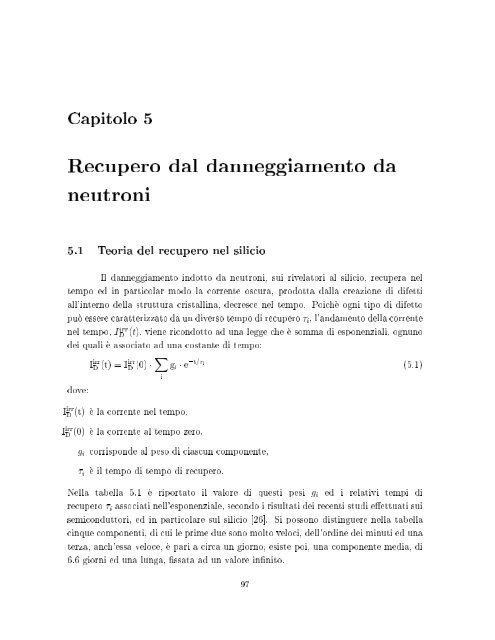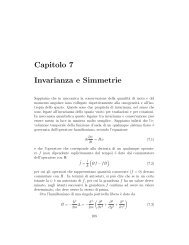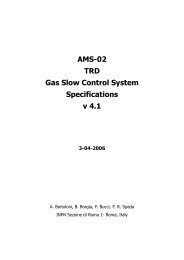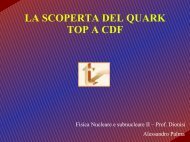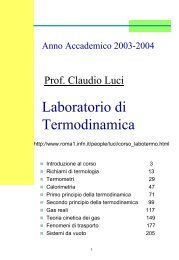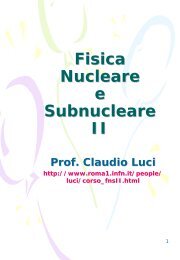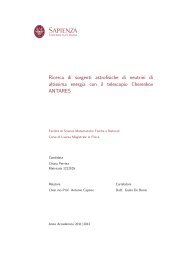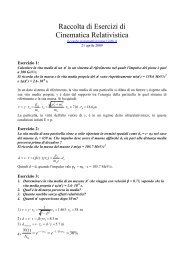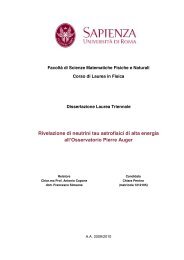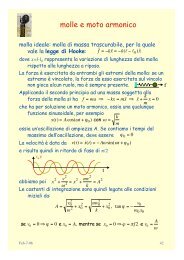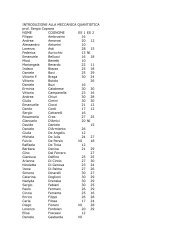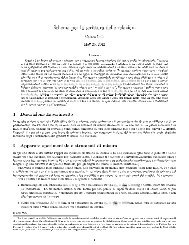Studio di fotodiodi a valanga per il calorimetro CMS al LHC del CERN"
Studio di fotodiodi a valanga per il calorimetro CMS al LHC del CERN"
Studio di fotodiodi a valanga per il calorimetro CMS al LHC del CERN"
Create successful ePaper yourself
Turn your PDF publications into a flip-book with our unique Google optimized e-Paper software.
Capitolo 5<br />
Recu<strong>per</strong>o d<strong>al</strong> danneggiamento da<br />
neutroni<br />
5.1 Teoria <strong>del</strong> recu<strong>per</strong>o nel s<strong>il</strong>icio<br />
Il danneggiamento indotto da neutroni, sui rivelatori <strong>al</strong> s<strong>il</strong>icio, recu<strong>per</strong>a nel<br />
tempo ed in particolar modo la corrente oscura, prodotta d<strong>al</strong>la creazione <strong>di</strong> <strong>di</strong>fetti<br />
<strong>al</strong>l'interno <strong>del</strong>la struttura crist<strong>al</strong>lina, decresce nel tempo. Poiche ogni tipo <strong>di</strong> <strong>di</strong>fetto<br />
puo essere caratterizzato da un <strong>di</strong>verso tempo <strong>di</strong> recu<strong>per</strong>o i , l'andamento <strong>del</strong>la corrente<br />
nel tempo, ID irr (t), viene ricondotto ad una legge che e somma <strong>di</strong> esponenzi<strong>al</strong>i, ognuno<br />
dei qu<strong>al</strong>i e associato ad una costante <strong>di</strong> tempo:<br />
I irr<br />
D (t) = I irr<br />
D (0) X i<br />
g i e ,t= i<br />
(5.1)<br />
dove:<br />
I irr<br />
D<br />
(t) e la corrente nel tempo,<br />
I irr<br />
D<br />
(0) e la corrente <strong>al</strong> tempo zero,<br />
g i corrisponde <strong>al</strong> peso <strong>di</strong> ciascun componente,<br />
i e <strong>il</strong> tempo <strong>di</strong> tempo <strong>di</strong> recu<strong>per</strong>o.<br />
Nella tabella 5.1 e riportato <strong>il</strong> v<strong>al</strong>ore <strong>di</strong> questi pesi g i ed i relativi tempi <strong>di</strong><br />
recu<strong>per</strong>o i associati nell'esponenzi<strong>al</strong>e, secondo i risultati dei recenti stu<strong>di</strong> eettuati sui<br />
semiconduttori, ed in particolare sul s<strong>il</strong>icio [26]. Si possono <strong>di</strong>stinguere nella tabella<br />
cinque componenti, <strong>di</strong> cui le prime due sono molto veloci, <strong>del</strong>l'or<strong>di</strong>ne dei minuti ed una<br />
terza, anch'essa veloce, e pari a circa un giorno; esiste poi, una componente me<strong>di</strong>a, <strong>di</strong><br />
6.6 giorni ed una lunga, ssata ad un v<strong>al</strong>ore innito.<br />
97


